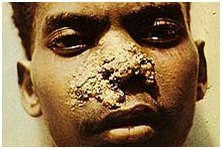Yaws
- font size decrease font size increase font size
 Like endemic syphilis and pinta, yaws (also known as framboesia tropica and pian) is a form of non-venereal treponematoses. The causative organism Treponema pallidum subsp pertenue is morphologically and serologically identical to T pallidum ssp pallidum (syphilis). Like syphilis, yaws has different s tages of disfig urement. However, unfortunately for the kids, yaws is not spread by sexual contact. The major route of infection is through direct person-to-person contact.
Like endemic syphilis and pinta, yaws (also known as framboesia tropica and pian) is a form of non-venereal treponematoses. The causative organism Treponema pallidum subsp pertenue is morphologically and serologically identical to T pallidum ssp pallidum (syphilis). Like syphilis, yaws has different s tages of disfig urement. However, unfortunately for the kids, yaws is not spread by sexual contact. The major route of infection is through direct person-to-person contact.
Yaws is a tropical illness that was once common in West Africa, Indonesia, New Guinea, the Solomon Islands, Haiti, Dominica, Peru, Colombia, Ecuador and parts of Brazil. In these countries, yaws most often affects children between the ages of 2 and 5, especially children who wear few clothes, have frequent skin injuries and live in areas of poor hygiene.
During the 1950s, yaws was a common tropical illness, infecting 50 million to 100 million people. However, since that time, the World Health Organization (WHO) has battled yaws in many tropical areas of the world and more than 50 million cases of yaws have been treated with penicillin. As a result, the incidence of yaws declined dramatically worldwide.
Yaws, just Like syphilis, has 3 stages of development:
- Primary (early stage)
- secondary
- tertiary (late stage)
Early Yaws — About three to five weeks after a person is exposed to yaws, a raspberrylike bump appears on the skin, commonly on the legs or buttocks. This bump, sometimes referred to as a frambesioma or mother yaw, gradually will grow larger and form a thin yellow crust. The area can itch, and there can be swollen lymph nodes (swollen glands) nearby. The bump usually heals on its own within six months, and it often leaves a scar.
Secondary Yaws — The next stage of yaws may begin while the mother yaw is still present, or it may not start until several weeks or months after the first stage of yaws heals. In this stage, a crusty rash forms, which can involve the face, arms, legs and buttocks. The bottoms of the feet also can become covered with painful, thick sores. If foot sores develop, walking can become painful and difficult, resulting in a crablike gait called crab yaws. Although the bones and joints also can be affected, second-stage yaws usually does not cause destruction in these areas.

Late-stage Yaws — Late yaws develops in only about 10 percent of people who are infected with yaws. It begins at least five years after the appearance of early yaws, and it has the potential to cause severe damage to the skin, bones and joints, especially in the legs. Late yaws also can cause a form of facial disfiguration called gangosa or rhinopharyngitis mutilans as it attacks and destroys parts of the nose, upper jaw, palate (roof of mouth) and part of the throat called the pharynx. If there is swelling around the nose, a person with late yaws can have headaches, nasal discharge and a distinctive facial appearance called goundou. (or gangosa)
 rr
rr
Treatment
It takes is a single shot of penicillin to treat yaws.
Surgical resection was the mainstay of treatment for goundou. In patients with limited forms of the disease with two paranasal excrescences the operation was simple, because there was an easily identifiable subperiosteal cleavage plane.
